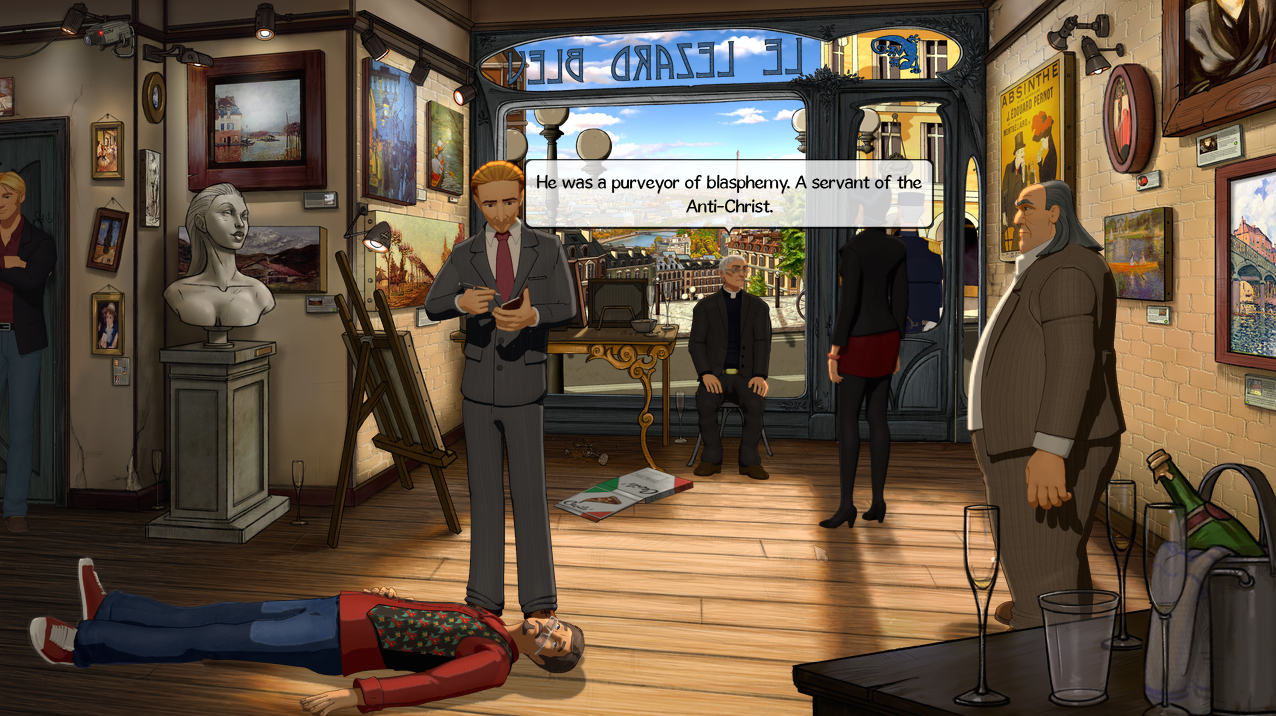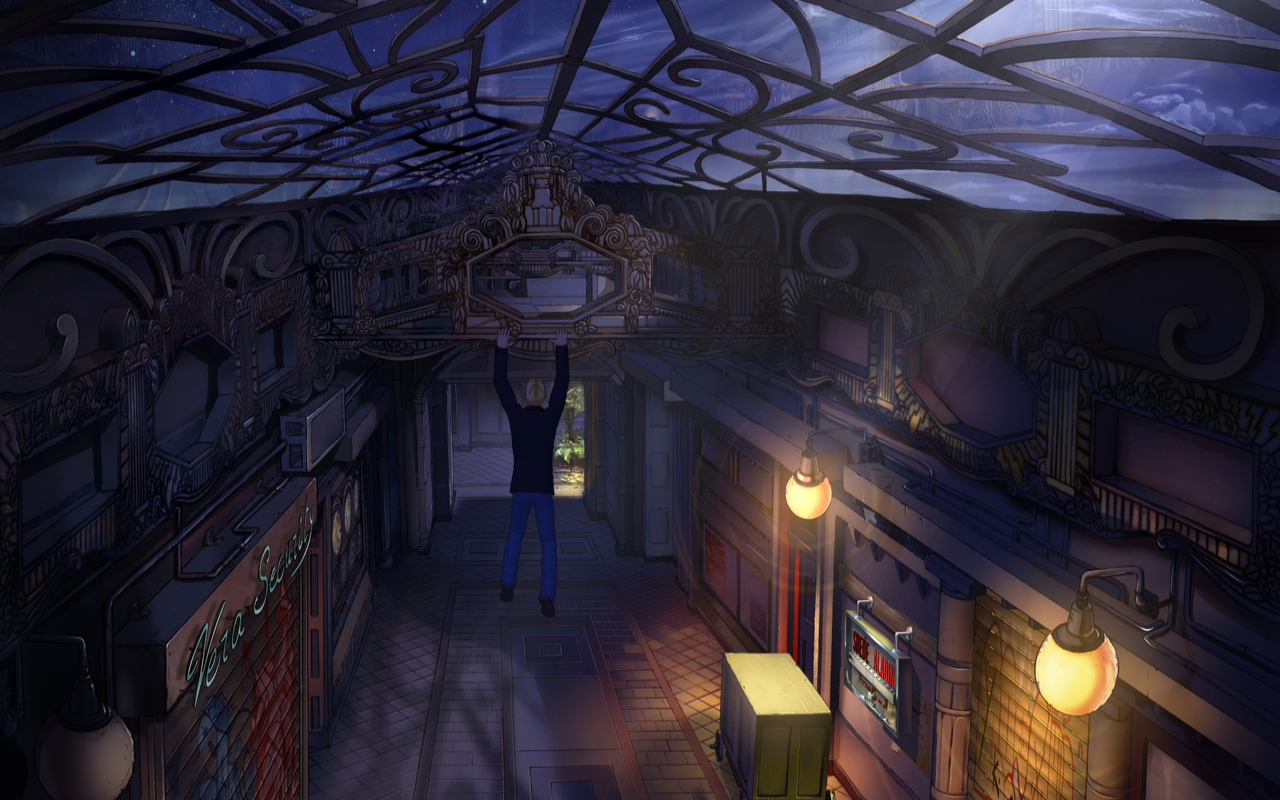Search
[{{{type}}}] {{{reason}}}
{{/data.error.root_cause}}{{{_source.title}}} {{#_source.showPrice}} {{{_source.displayPrice}}} {{/_source.showPrice}}
{{#_source.showLink}} {{/_source.showLink}} {{#_source.showDate}}{{{_source.displayDate}}}
{{/_source.showDate}}{{{_source.description}}}
{{#_source.additionalInfo}}{{#_source.additionalFields}} {{#title}} {{{label}}}: {{{title}}} {{/title}} {{/_source.additionalFields}}
{{/_source.additionalInfo}}- Details
- Category: Computer
- By J. Todd Cumming
- Hits: 6026
Broken Sword 5: The Serpent's Curse (Mac)

Broken Sword 5
Developed by: Revolution Software
Published by: Revolution Software
Released: December 4, 2013
Available on: Windows, Mac OS X, Linux, PlayStation 4, Xbox One, PlayStation Vita, iOS, Android
Genre: Adventure
ESRB rating: T
Number of players: 1
Price: $24.99 (Steam), $4.99 (iOS), $4.99/$5.99 (Android – each episode sold separately)
Thank you, Revolution Software, for sending us a copy of this game to review!
The latest entry of the Broken Sword series was highly anticipated, bringing in more than $800,000 in donations through Kickstarter. It seems a lot of people wanted to see the continuing adventures of French journalist Nico Collard and the American George Stobbard, and this game succeeds quite well.
The game plays similarly to the first two Broken Sword games, and has a similar theme as the first one in exploring the early years of Christianity. The game starts with a murder in an art gallery, in broad daylight during the opening of a new exhibit, no less. A helmeted thief bursts into the gallery, takes one painting off the wall, shoots the museum owner dead, and takes off on his motorcycle. While Nico follows to try and take photos, George remains behind to talk to the others and investigate the scene. He works for the company insuring the exhibition, so it's his job to make sure the company doesn't suffer a big loss because of the theft and the murder. He's able to determine that the alarm on the picture was disabled... but the value of that painting, known as La Malediccio, is one of the lowest of the art on display. A priest also on the scene reports that the painting is evil, containing hidden messages from the Gnostics... but was that the motive behind the theft? Or is there something else going on? The first half of the game focuses on the theft of the painting itself, while the second half of the game focuses on the messages of the painting and the connections to the Gnostics. Interestingly enough the game allows you to play at the start of Part 2 if you want, skipping the entire first half if you choose.
The gameplay is similar to the remakes of the first two Broken Sword games. Use the mouse to collect inventory items, talk to people, and use objects to figure out how to proceed through the game. The interface consists primarily of graphics, and there are a variety of language options available. There are a few puzzles, but not very many. The humor is solid here, and you can direct George to offer a crumbled cookie to other people, or show off his new pet, a cockroach named Trevor. The voice acting is humorous with the different reactions the other characters provide. Some of the humor can be juvenile, though – there is an abundance of "potty humor" in trying to get a police officer to leave the scene in order to use the bathroom. Although a hint system is available, the challenges are not too difficult, especially if you pay attention to the clues that occur earlier in the game. There are a lot of hidden Easter eggs, though – objects that don't change the mouse pointer when you move the cursor over them, but react when you click on them – and discovering some of these is needed to get all the achievements in the game.

Strong Points: Good graphics and voice acting; good pacing for a long game
Weak Points: Challenges aren't too difficult
Moral Warnings: On-screen deaths; murders; language; crude humor; Gnosticism serves as a central focus to the plot
The graphics in the game are quite nice, with 3D-rendered figures moving through the 2D scenes. It's easy and clear to see what's going on, even though the figures don't always move their mouths along with the words they're speaking. The sound effects are good as well, and the music fits the mood nicely. The controls are sharp and responsive, and the gameplay is hefty, lasting well over 10 hours, without feeling slow or laborious.
Some of the moral aspects of the game have already been discussed, namely in the aspect of the juvenile, potty humor. There are some light language issues as well, but nothing that is more than what you could expect from prime-time television. Although people do get shot and killed in the course of the adventure, very little blood is shown. There also is quite a bit of alcohol in the game, and it is necessary to get at least one person drunk in order to proceed. There are some supernatural elements and magic use in the climax of the game, but other than that, there aren't any supernatural aspects to worry about.
From a Christian perspective, there is the subject of the Gnostics that may cause some concern. A religious movement that started sometime after the death of Christ, the Gnostics were those devoted to alternate writings that didn't make it into the Bible. Many of these writings were considered to be heretical in nature, and the Catholic church even set up a specific division to hunt down heretics, put them to the sword, and destroy their works. As a result, the few Gnostics that weren't killed went into hiding. It's a dark, little-known chapter of Christian history. Some of these writings have been recovered, especially in the "Nag Hammadi library" that was discovered in a farm in Iran in 1945. While La Malediccio and the "Tabula Veritatis" in the game are fictional, these parts of the game were inspired by the "Testimony of Truth." A fragmentary portion of this was discovered in the Nag Hammadi Library, and some of the recovered text depicts the creation story of Genesis from the serpent's point of view. In that portion, he is portrayed as a being who grants wisdom and knowledge, in contrast to a flawed "Lord" who promises death if Adam and Eve gain this knowledge, and forces them into exile when they do gain wisdom.
The game touches on some of the Gnostic teachings and interpretations, including the idea that Lucifer and Jehovah are equals and need to be balanced. The game also discusses, through the character of Father Simeon, the origins of the Dominican order and the idea that Gnostic works are false, heretical and dangerous teachings. Simeon even goes as far as to state that Gnostic lessons can be used to summon demons, and that no good can come of even the existence of Gnostic writings. Although it is an interesting approach to a little-known subject, this may expose some Christians to aspects of Christianity that may, in their beliefs, lead them away from their churches. I tend to find theology and religious history interesting so these elements don't bother me, but other viewers may need to give it careful consideration before jumping into the game.

Higher is better
(10/10 is perfect)
Game Score - 90%
Gameplay - 17/20
Graphics - 9/10
Sound - 9/10
Stability - 5/5
Controls - 5/5
Morality Score - 52%
Violence - 3/10
Language - 6.5/10
Sexual Content - 5/10
Occult/Supernatural - 4/10
Cultural/Moral/Ethical - 7.5/10
The Gnostics in the game – most of them, at least – are portrayed as gentle, but fearful, people. Although the developers could easily have depicted Father Simeon as the main opponent, they nicely avoided that route. Even though Simeon views it as his God-given calling to track down and destroy heretical materials, he seems to want to do this through legal means. In the game, he's trying to find the owner of La Malediccio in order to persuade him or her to destroy the painting – he isn't the type of character to rip it off the wall and burn it in the middle of the art gallery. The writers sometimes take a bit of a heavy hand in their efforts to display Gnosticism as a harmless, or even benevolent faith. However, Christians who are in tune with the Holy Spirit can see through the deception – any attempt to show Lucifer in a good light is certainly a fitting attempt from the "Prince of Lies." Keep this firmly in mind while playing the game.
Another significant factor in terms of morality consists of nude works in the art gallery and the owner's apartment. Although not terribly detailed – except for a few behind shots – there are some paintings that contain full nudity, including from the front. It's blatantly apparent that the model for most of the nude paintings is one of the characters that you interact with frequently in the first half of the game, too. So even though she doesn't get undressed in the game, you know what she looks like under those clothes.
A minor flaw that popped up in the second half of the game was a disconnect between the voice acting and the speech bubbles. The character's voices would say one thing, but the words floating above their heads read something else entirely. It's a minor quibble to an otherwise good game, but it does seem that an editor fell asleep while proofreading one day.
All in all, Broken Sword 5 is a solid adventure game that is well worth the $25 price tag, and is an even better bargain when purchased as part of a sale or bundle. The only major concern might be nudity and, of course, the aspects of Gnosticism. Whether or not that adds to the appeal of the game, or detracts from it, is something I'll leave up to you.








